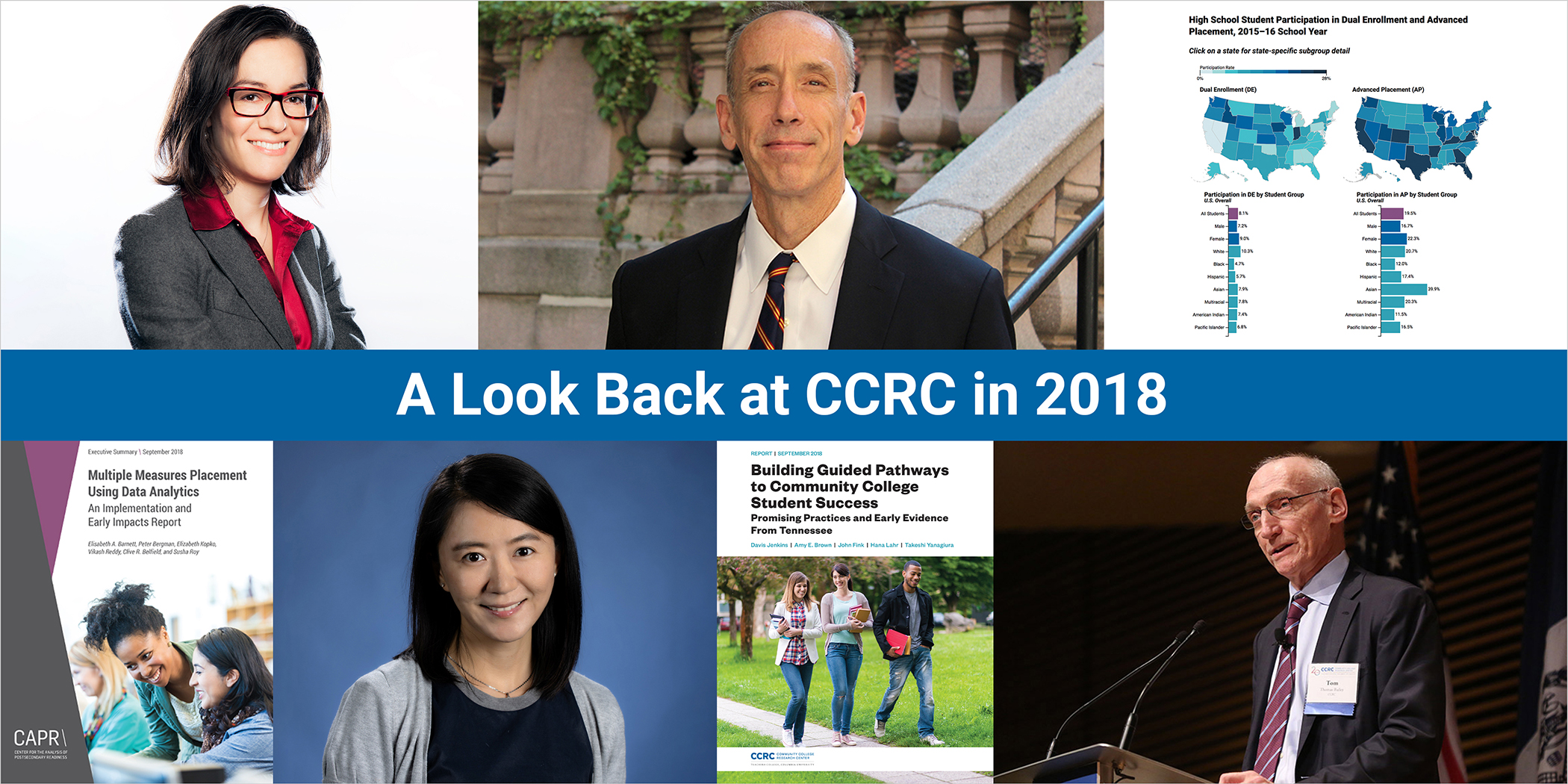Over the past year, CCRC reached several milestones, produced important new research findings, and welcomed a new center director. Before we embark on the new year, here’s a look back at some highlights from 2018.
January: The Brookings Institution Publishes Judith Scott-Clayton’s New Analysis on the Looming Student Loan Default Crisis
CCRC Senior Research Scholar Judith Scott-Clayton is a leading voice on financial aid and college affordability. In January, the Brookings Institution published her new analysis of federal data on student debt and repayment. Scott-Clayton found that cumulative default rates continue to rise even more than a dozen years after a student first enters college. Nearly 40% of borrowers who started in 2003–04 could default by 2023. Debt and default rates among Black students and among those who attend for-profit colleges are particularly disturbing.
February: CCRC Posts Its 100th Working Paper
Thirteen years ago, CCRC introduced its working paper series to get new information and analysis out more quickly. In February, the center published its 100th working paper. Written by John Fink, Davis Jenkins, Elizabeth Kopko, and Xiaotao Ran, the paper examines why community college transfer students often end up with excess credits that do not count toward a bachelor’s degree.
March: Thomas Bailey, CCRC’s Founding Director, Chosen as President of Teachers College
Teachers College announced that Thomas Bailey, who spent 27 years as a TC professor and more than two decades at the helm of CCRC, would be the college’s next president. Bailey oversaw the transformation of CCRC from a germ of an idea in 1996 to the nation’s foremost independent source of research on community colleges. He assumed the presidency of TC, Columbia University’s graduate school of education, health, and psychology, on July 1. He was inaugurated on December 7.
May: CCRC Researchers Earn Graduate Degrees
CCRC has employed more than 125 graduate students since its inception, and five such scholars earned their diplomas in May. Four were awarded degrees from TC: Diana Cruz was awarded an MA in education policy; Hana Lahr earned a PhD in education policy; Xiaotao Ran completed a PhD in economics and education; and Susha Roy earned an MA in economics and education. Lauren Pellegrino completed a PhD in educational research and policy analysis at North Carolina State University.
In December, Danielle Jarvis earned an MA in education policy from TC.
June: Thomas Brock Named CCRC’s New Director
The next chapter in CCRC’s history will be led by Thomas Brock, who became the center’s second director on September 1. Brock, who served as research commissioner at the Institute of Education Sciences, brings more than 25 years of experience in applied research in education and social welfare to CCRC. In a letter introducing himself to the CCRC community, Brock wrote that the center will expand its work on effective teaching, college costs, and academic advising; he also emphasized equity as a fundamental focus of CCRC’s research moving forward.
June: CCRC Alum and Affiliate Di Xu Is Recognized for Her Research
The National Science Foundation awarded CCRC affiliate Di Xu its prestigious five-year CAREER grant to further her research into online STEM courses. Xu, who is an assistant professor at the University of California, Irvine, will focus her investigation on strategies for improving STEM gateway courses and student engagement in online coursework. The grant will allow Xu to expand upon work she contributed to at CCRC, which centered on student success in online courses.
September: CCRC Researchers Publish a Dispatch From Tennessee, a Laboratory for Guided Pathways Reforms
Community colleges in the Volunteer State are among the nation’s leaders in implementing guided pathways reforms. A CCRC report released in September examined how things are going in Tennessee from both operational and student-outcomes perspectives. Researchers described promising trends in early momentum metrics, examined equity gaps at the community colleges, and considered what’s next for the Tennessee system.
September: CAPR Releases Early Impacts Report on Multiple Measures Placement
With more colleges around the country moving away from reliance on standardized tests alone to decide developmental or college placement, CAPR’s rigorous study of multiple measures placement is beginning to provide experimental evidence that the approach helps students. In the first of two major reports, the authors of the multiple measures placement study wrote that students evaluated using the multivariable system were more likely to place into and complete college-level courses in their first term. The final results of the study, which relies on data from 13,000 students at seven SUNY community colleges, will be released in 2019.
November: Interactive Tool Illuminates Disparities in Access to Dual Enrollment and Advanced Placement Courses Across the United States
Students in Indiana are more likely to participate in dual enrollment programs—which allow high school students to take college courses—than those in Arizona. A far greater percentage of learners take AP courses in Florida than in Wyoming. And female students across the United States are more likely to enroll in either early college program than their male counterparts. These insights are gleaned from several data points on display in the interactive map CCRC researchers posted in November. The tool compares participation in dual enrollment and AP by gender, race, and state.
We wish everyone a safe and happy holiday season and look forward to more exciting research in the new year!




